Self-repair of a well: an overview of the best methods of restoration and resuscitation
The trunk and equipment of a private water source tend to wear out gradually. To restore the technical condition, it is not necessary to resort to the services of hired workers, the owner of the development can carry out a well repair with his own hands. But first, you should familiarize yourself with the ways of resuscitation of the source. Is it true?
Here you will find valuable recommendations and a description of important nuances that ensure success in correcting the state of development. We described in detail the options for repair work and the technology for their implementation. The basis for the information presented by us is construction standards and the experience of owners of sections with wells.
The article thoroughly examined all sorts of reasons for violations in the work of an autonomous water intake structure. Describes how to clean the source and describes the method of replacing the casing. As excellently illustrating the theme of additions, photos and video applications are given.
The content of the article:
Signs and preconditions for repair
The owner of the water well must constantly monitor the health of the source. This is in his own interests, because the sooner a failure is detected and corrected, the cheaper and easier the repair will be. Sometimes enough timely cleaningso that the hydraulic structure works normally again, and the problem does not worsen.
It is worthwhile to deal with the diagnosis of breakdowns and troubleshooting if the water quality has deteriorated or the productivity of the well has decreased. As for changes in water quality, they are best seen by the results of chemical and microbiological analyzes.
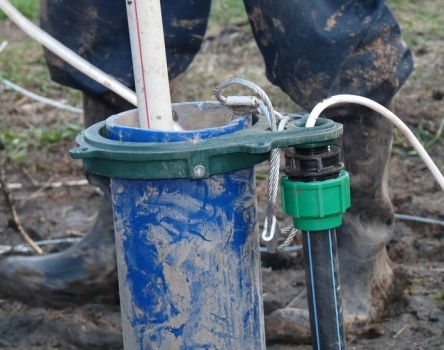
Decrease in productivity becomes obvious when water ceases to be enough for usual needs or it disappears altogether.
Water quality change
Ideally, every owner of any hydraulic structure should regularly take water samples to a local laboratory to determine its suitability. However, in practice, few people carefully monitor the wells, so you have to rely on a subjective assessment.
Changes in water should alert:
- turbidity;
- the appearance of sediment during sedimentation;
- taste change;
- the appearance of an odor.
A reddish precipitate and an unpleasant aftertaste may indicate an increased iron content. Most often, the problem is not in the well itself, but in the erosion of iron-containing rocks by water. In this case, it is not necessary to repair the structure, it is enough to install filters with deferrizing cartridges.
If the water becomes cloudy and has a putrid odor, then the problem may be in bacteriological contamination. Water can not be drunk, and even more so given to children until the well is cleaned.
After cleaning, you will need take a sample for analysisin order to obtain confirmation from laboratory specialists that the water is potable and safe for health.
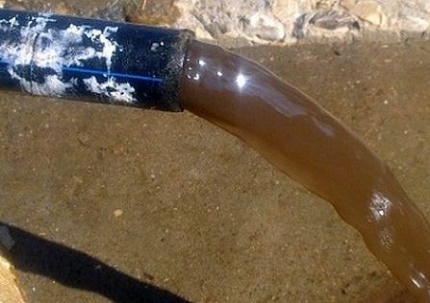
Well productivity decline
A decrease in well productivity can occur gradually or dramatically.
There may be several reasons for this:
- Clogging. As a rule, owners of sand wells face such a problem. Artesian springs usually do not silt. Particulate matter first gets into the primary filters, and later into the fine filters. A decrease in well production occurs gradually. In this case, you need to clean the structure.
- Malfunctions in the pump. Eternal technology does not exist, and pumping equipment breaks in the same way requires replacement. In some cases, cleaning the device and preventative maintenance are sufficient, and sometimes you have to buy a new pump. If the productivity of the well has decreased, the pump should be examined first.
- Casing pipe wear. If malfunctions in the operation of the well arose a few years after construction, then the problem may be in the pipes. They rust over time. The lower the quality of the materials of which the production casing is made, the earlier it is necessary to repair the structure. Often due to rust, leaks occur at the joints of pipes.
- Errors of design and installation of the well. If the source is initially poorly constructed, then it will be very difficult to establish its work. It is worth turning to professional drillers in order to understand why difficulties have arisen and to solve the problem. Often the only reasonable way out of the situation is the construction of a new well.
It is very important for future trouble-free operation competently equip a water source immediately after drilling. It is necessary to protect the mouth of the mine with a head or arrange a caisson for servicing and placing equipment, install a filter and lay a pipeline taking into account construction requirements.
It is worth noting that sometimes a drop in water level in an aquifer simply happens. It is understood that as a result of long-term operation of the water supply source, the water supply may be reduced.
It is impossible to influence this, but you can contact the company engaged in drilling in the area, consult with specialists on how to solve the problem.
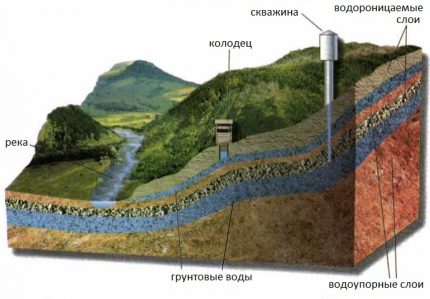
Flushing as a breakdown prevention
Often you can find a recommendation to flush the well to prevent siltation. Usually such advice is given by drilling specialists. Many well owners have a suspicion that they are simply tied to a certain company, which will deal with their water supply system after the arrangement.
Do you really need preventive flushing or is it still a trick? If the well works continuously, then there is no particular need for such an event. But for the design, which is used only seasonally or temporarily, it is advisable to periodically flush to avoid settling of sand and silt.
Sometimes regular flushing can really prevent the repair or restoration of the well, but most often they are not needed. Extra flushing will not hinder in case of difficulties with putting the well into operation after construction or a long downtime.
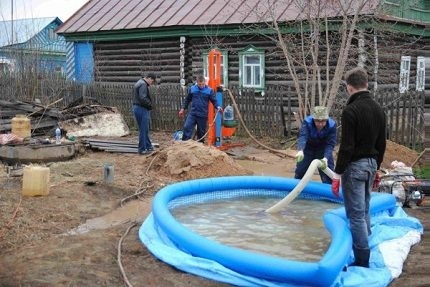
Subtleties of diagnosis
To eliminate the breakdown, you need to clearly understand its cause. If you plan to repair the well yourself, then if the diagnosis is incorrect, the owner will lose only time. If he turns to professionals, then also money. Therefore, you should not rush and carefully consider the diagnosis.
First of all, you need to make sure that the problem is really in the hydraulic structure itself, and not in the water distribution system. To do this, the pump is disconnected from the water supply, connected to a conventional hose and put into operation.
If the water comes with good pressure, then everything is normal with the well and pumping equipment. The source of trouble is worth a look. in the water distribution system. If the pressure is weak or the water does not flow at all, and the pump is idling, you really need to do the resuscitation of the well with your own hands or call specialists.
To check the pump, you have to get it and temporarily connect another. If no changes occur, equipment failure can be ruled out. In this case, you will have to clean the well or deal with malfunctions of the production casing.
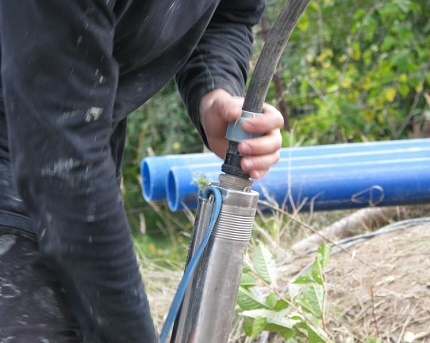
In the case of self-diagnosis, it is necessary to act by the method of exclusion, checking each node in turn. Investigation of the borehole of the special equipment is impossible, you will have to call the employees of the drilling company.
To clean the wellfilter or replace the production pipe, you should also resort to the help of drillers. If it is simply silty, then it is possible to restore performance. In serious cases, you should hire professionals. And even in this case, there is no full guarantee that the productivity of the well will be restored.
Four ways to clean a well
If during the diagnosis it turned out that the problems arose due to siltation, then the well can be cleaned independently. To do this, it is washed with water or purged with a compressor.
The easiest option is to pump with water. The process requires considerable time and effort, but the result is worth it. If the filter is not destroyed, but simply dirty, then it is completely possible to completely restore the source's productivity.
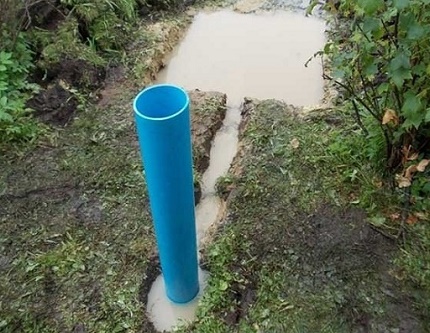
Method # 1 - flushing with a pump
Have to stock up on clean water in advance. If your own well works poorly, this can become a whole problem, you will need to turn to neighbors for help. Water will require a large tank and a pump, and finding them can also be difficult.
If these issues are resolved, then you can begin to work. The hose is connected to the pump and lowered to the bottom of the well. It is important that he gets not just to the mirror of water, but almost to the bottom.
The pump is turned on to pump water, and it raises sludge and sand from the filter. The wellbore quickly overflows with water, and it begins to gush uncontrollably. Particles of contaminants are released along with water.
[the_ad_placement id = ”mobile-vstavka-v-tekste-5“]This is one of the fastest and most reliable ways to clean a silty source. If you can’t do it yourself, you can turn to hydrogeologists and cesspool workers. The former will calculate the required power of the hydraulic shock, and the latter will help with a large volume tank for the removal of excess water.
Method # 2 - cleaning with a vibrating pump
A shallow well can be cleaned of silt and sand with vibration pump. Often use small diameter equipment, for example, devices of the brand "Kid". The pump is lowered into the shaft of the mine to the level of the filter, turn on and gently swing the well.
The device will pick up solid particles and they will come to the surface with water. Such a flushing of the well may take several days, but it will be effective only if light contamination.
During well cleaning, the working parts of the pump may become clogged with dirt and the motor may overheat. Therefore, it is advisable to take breaks and clean the device from contamination.
The advantage of this method is its simplicity and cheapness. Everything can be done with your own hands; no complicated equipment is required.

Method # 3 - use a bailer
This method is suitable only for shallow wells - not more than 30 m. For work, helpers, a winch and drill bit. It is a piece of metal pipe with a top closed by a net and a bottom washer. The bailer is attached to a long, durable cable.

The device is lowered to the very bottom of the well, after which it is raised by about half a meter and again sharply lowered. After several such manipulations, the bailer is removed from the well and cleaned of sand. Usually it gets about 0.5 kg.
Not all well owners consider this method of cleaning to be effective, but most nevertheless agree that the bastard helps to cope with siltation. The main advantage of cleaning using a bailer is low cost. If you make the device yourself, you can remove the sand almost for free.
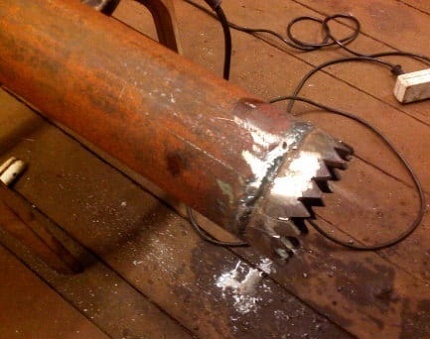
Method # 4 - flushing with two pumps
The method is similar to flushing with a pump, but has some differences. Two pumps are required - submersible and surface. Not far from the well, a volumetric water tank (from 200 cubic meters) should be installed, and in it - a home-made filter made of a bucket with a net or a female stocking. A hole is made at the side and bottom of the tank through which water will be pumped using a surface pump.
Using a deep pump, contaminated water is pumped into the tank, passing through a filter. Surface pump collects purified water from the tank and re-injects it into the well. The bucket is periodically freed from sand and silt. The procedure is carried out until clean water without impurities flows from the well.
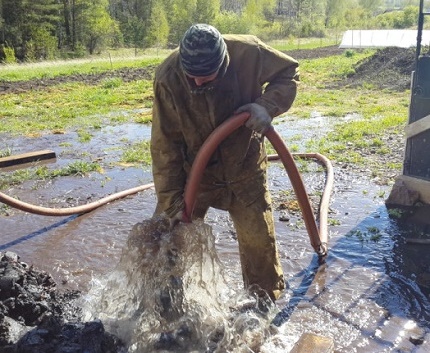
Production string replacement
One of the most unpleasant breakdowns is wear of the production pipe. Its replacement is a complex and time-consuming process requiring considerable financial investments. It is best to entrust the work to professional drillers. For self-fulfillment, it is desirable to have the appropriate skills, as replacement downhole pipe even more complicated than installing a new one when drilling a well.
It is easiest to work if the casing and production structures consist of two pipes of different diameters. In this case, only the production pipe is changed without touching the casing. If everything is done carefully, the well’s performance will be restored.
A well with asbestos-cement pipes should not even be repaired, as material is destroyed under additional loads. This is the case when it is worth immediately starting the construction of a new hydraulic structure. But the metal pipe is quite possible to replace, even if the material is very rusty.
To dismantle the pipe, it is gripped with a loop or a special clamp and pulled out using any available lifting mechanism - a railway jack, a truck crane, etc. The main thing is that the device provides the necessary strength for lifting.
When the pipe is removed from the shaft, install a new one - metal or plastic. Do not use asbestos cement. Material is impractical and potentially hazardous to health. This is confirmed by data from the World Health Organization.
New pipes can be connected using threads or nipples. You should choose high-quality connecting elements with a special anti-corrosion coating. If plastic pipes are selected, a durable, non-nipple connection is provided here. When choosing pipes, you should not save. This is fraught with new breakdowns.

Important downhole filter information
When cleaning a well, it is important to be careful, otherwise you can accidentally destroy the filter, especially if a water hammer is used. If cleaning the filter with chemicals was used, then the quality of the water will inevitably deteriorate. Do not worry. This is a temporary phenomenon.
Gradually, the well will be cleaned of chemistry, and the water will again become quality. So that the reagents do not have a negative impact on health, you should pump water from the well for 12 hours and for a couple of days abandon its use for domestic purposes. Also need to put good filters in the house and do not use unfiltered water for drinking and cooking until it is cleaned.
When dry cleaning a well filter, substances that are used in the food industry are used, therefore it is generally believed that they are safe. However, you should always remember the quantity. The concentration of chemistry in the water after cleaning is too high. Reasonable precautions must be taken to prevent poisoning.
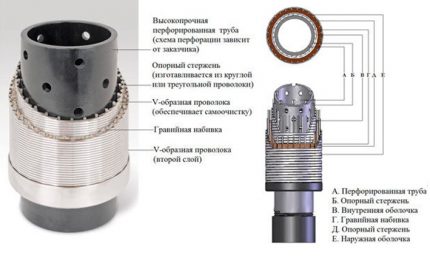
In addition to chemical cleaning of the filter, you can use mechanical. This method is safe and does not affect water quality. To clean the filter from deposits, use a metal device that looks like a normal brush for washing bottles, but much larger.
At the same time as the ruff, you can use cleaning using water injection. But you should always remember the risks. The filter may not withstand the extra pressure and may break. Better not to experiment without extreme need.
Conclusions and useful video on the topic
Video # 1. Demonstration of siltation of a well and presentation of its pumping process on its own:
Video # 2. How to clean a well with the help of the simplest homemade bailer:
Unfortunately, you can never be sure that after recovery, the well will work fully and smoothly.
There are cases when resuscitation of a well is impossible at all, especially if it is placed on sand and the filter is not removable. Then it’s easier to arrange a new source than to bring the old one back to life, because in the end, the forces and means for this will be spent about the same.
If there are problems with the new well, it means that it was originally constructed incorrectly. The contract with the driller company usually indicates the warranty period, so it is possible to have its employees determine the cause of the malfunction and eliminate it, if possible.
Problems with the pump, filter, siltation - this is solved. But the replacement of a completely destroyed filter or worn trunk pipes will lead to serious costs with an uncertain result. Here it is necessary to decide what is more profitable - restoration of the old well or construction of a new one.
Tell us about your own experience gained during well restoration, share only the nuances of work known to you. Please write comments in the block below. Ask questions, post a photo on the topic of the article.

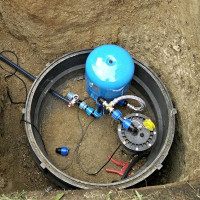 How to arrange a well without a caisson: an overview of the best ways
How to arrange a well without a caisson: an overview of the best ways 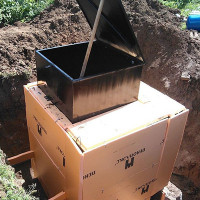 How to warm a well for the winter: an overview of the best ways + material selection
How to warm a well for the winter: an overview of the best ways + material selection  Do-it-yourself well cleaning: a review of common clogging causes and best cleaning methods
Do-it-yourself well cleaning: a review of common clogging causes and best cleaning methods 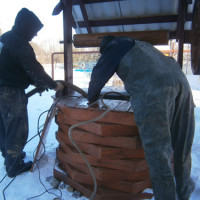 Water purification from a well: an overview of the best and most effective ways
Water purification from a well: an overview of the best and most effective ways 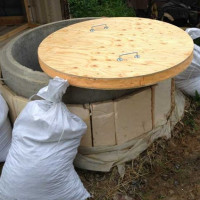 Do-it-yourself well warming for the winter: an overview of the best materials and methods of warming
Do-it-yourself well warming for the winter: an overview of the best materials and methods of warming  How to make a do-it-yourself filter for a well: an overview of the best home-made options
How to make a do-it-yourself filter for a well: an overview of the best home-made options  How much does it cost to connect gas to a private house: the price of organizing gas supply
How much does it cost to connect gas to a private house: the price of organizing gas supply  The best washing machines with dryer: model rating and customer tips
The best washing machines with dryer: model rating and customer tips  What is the color temperature of light and the nuances of choosing the temperature of the lamps to suit your needs
What is the color temperature of light and the nuances of choosing the temperature of the lamps to suit your needs  Replacement of a geyser in an apartment: replacement paperwork + basic norms and requirements
Replacement of a geyser in an apartment: replacement paperwork + basic norms and requirements
I bought a site with an old well. It turned out that it was all clogged with silt, and it was necessary to clean it. You can do it yourself, but still the question arises, where to get a pretty impressive amount of water for flushing. Therefore, I hired workers, they had their own pump, and they drove a water carrier too. I had to pay normally, but in a few hours the problem was resolved, and now the well is functioning normally.
Hello, what should I do if the water runs along the pipe, that is, not only inside, but also outside (the spill), a depth of 17.5 m? L.O. Gatchina district